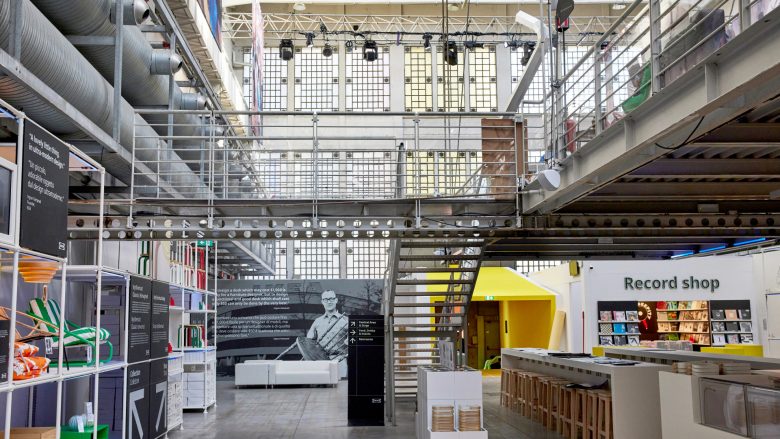

This year’s Ikea exhibition at the Fuorisalone, designed by architect Midori Hasuike and spatial designer Emerzon, generated a social atmosphere with its welcoming design.
Key features
Taking over the historical Padiglione Visconti building, the exhibition playfully juxtaposed the former factory’s imposing demeanour with an eclectic mix of colours and bright lights standing out against its concrete and exposed steel structure. Running across the length of the space were two lightweight frames housing Ikea products. One side showed archival furniture pieces, celebrating the brand’s 80-year history, while the opposite unveiled the new Nytillverkad collection. Four highly immersive installations were in focus, each depicting a natural element and offering a moment to reflect on the relationship between our homes and the planet. Playful lighting, made of Ikea bowls and light bulbs, further animated the space and cultivated a theatrical air around the subject of sustainability.
The frames were constructed using modular components, a nod to the brand’s functional design approach, and this allowed for a diverse arrangement of products across shelves of varying heights. Their white colour and straightforward design transported the visitor into an elaborate Ikea showroom, while the installations were made with rented metal scaffolding that reflected the building’s industrial history. The exhibition’s open plan, combined with the addition of Ikea couches and chairs on an existing raised platform, provided a variety of casual spaces for social interaction. Formal talks were organised as well, including one by Ikea’s first artist-in-residence, Annie Leibovitz, whose work was also on show.
FRAME’s take
Ikea powerfully demonstrates how design can elevate the role of the visitor by immersing them in a dynamic and thought-provoking environment. The leading brand’s exhibition provided opportunities for formal and informal interaction, generating a positive buzz that enlivened the space. The goal was not merely to exhibit but to provide room for discussion about the past, present and future, adding depth to the highly visual experience. Sustainability was addressed through its engaging installation work, while its circular building approach expanded on this in a subtle manner that was less in-your-face. Continuously animated by an abundance of activities, many of which were linked to other creative industries, this exhibition highlights how brands can creatively explore design’s cultural intersections and generate a sense of community. A space that would otherwise feel anonymous was made accessible, welcoming and personal, reflecting Ikea’s masterful knowledge in designing for comfort in the home.
Architecture: Midori Hasuike
Design: Emerzon
Images courtesy of IKEA


















